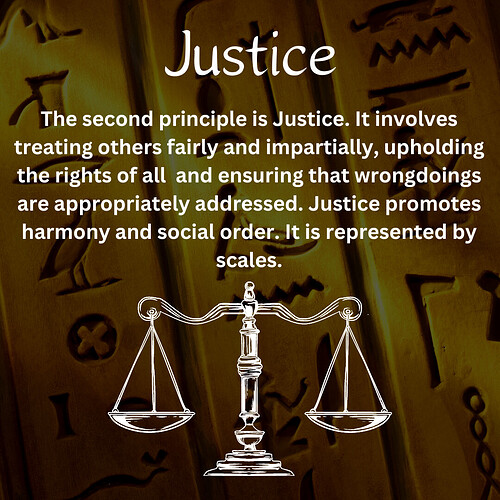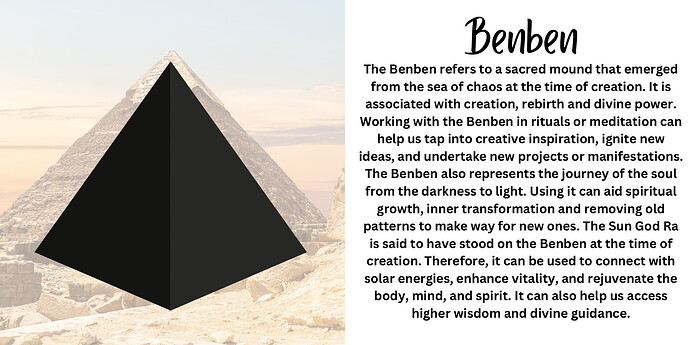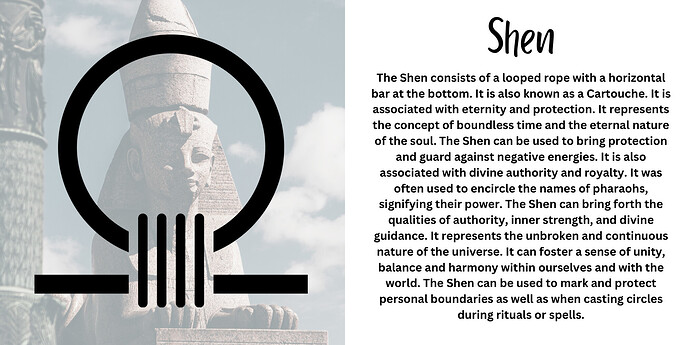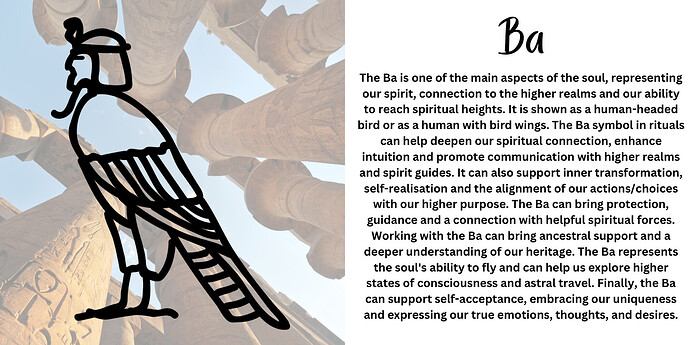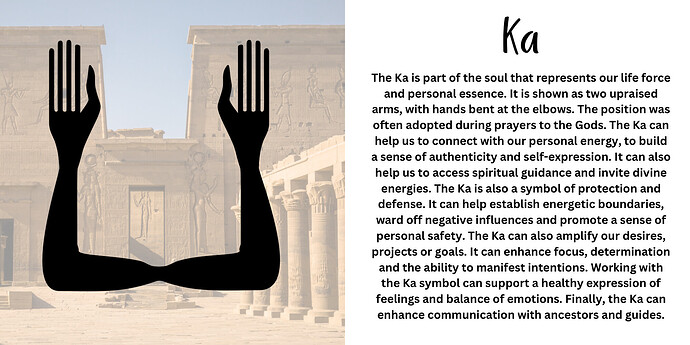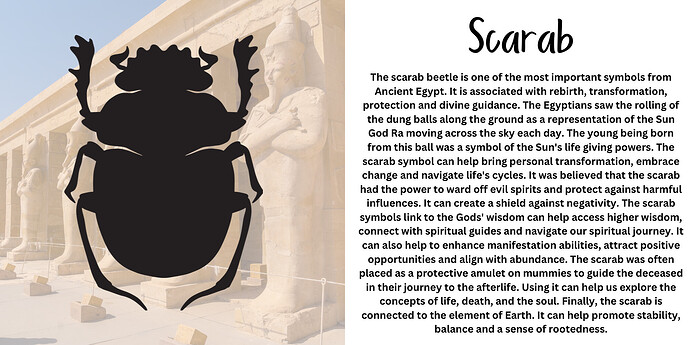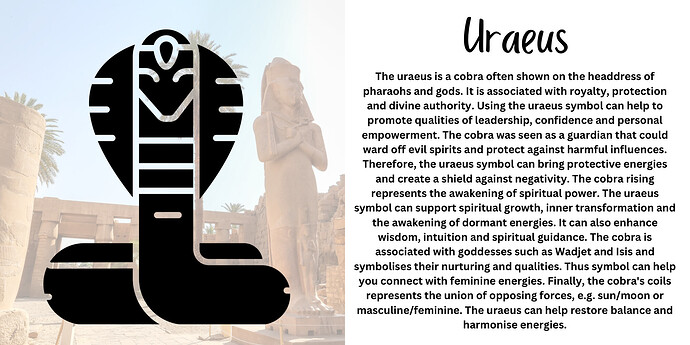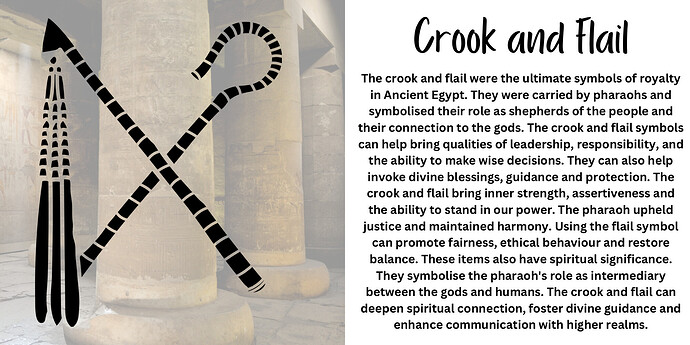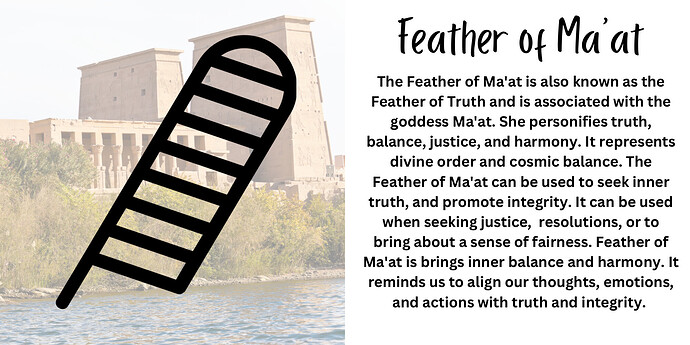Hello everyone,
It was quite difficult for me to choose something for this week’s challenge and therefore, I decided to pull everything I know together into a FAQs page of Egyptian beliefs. My hope that it might serve as a useful and informative tool for those with an interest in Egyptian practices but also that it may spark an interest in those who do not necessarily work with Egyptian deities or practices.
I hope you find this interesting
Blessed be
Alan
What is Kemet?
Kemet is the name that the ancient Egyptians gave to their land. The word means black land. This relates to the fertile black soil that was cultivated by ancient Egyptians on the banks of the Nile. The uninhabitable desert land was known as Deshret, meaning red land.
The word Kemetic is derived from Kemet. It means related to Kemet and can be used to refer to the people of ancient Egypt, their society, beliefs and practices.
Kemeticism is a modern spiritual practice that aims to recomstructnthe beliefs and practices of ancient Kemet. It’s followers may be referred to as Kemetics.
Who are some of the key gods and goddesses of the ancient Egyptian pantheon?
The Egyptian Pantheon has literally thousands of deities. Some are local Gods and Goddesses while others are the Hugh profile, national deities that many are familiar with today. The deities of ancient Egyptian are known collectively as the Neteru. A single deity is a Neter (male e.g. Thoth or Osiris) or Neteret (female e.g. Isis and Bast).
One of the most prominent groups of Neteru in the Ancient Egyptian pantheon is the Great Ennead of Heliopolis. This group of deities were important figures in the Egyptian creation myth and represented the cycle of birth, death and rebirth:
Ra: The sun god and creator deity, sometimes depicted as the primeval mound from which all creation emerged.
Shu and Tefnut: Ra’s children, who represented air and moisture.
Geb and Nut: Nut is often shown as a woman arching over theEarth. She represents the sky and was said to swallow the sun each night and give birth to it again each morning. Geb is shown as a man lying down, representing the solid ground.
The children of Geb and Nut:
Osiris: God of the underworld, agriculture, and rebirth.
Isis: Goddess of motherhood, protection, magic, and healing. Wife and sister of Osiris.
Set: God of deserts, storms, and disorder. Brother of Osiris and Isis.
Nephthys: Goddess of the dead, mourning, and childbirth. Sister of Osiris and Isis, wife of Set.
Other major deities in the Egyptian pantheon include:
Horus: God of the sky and kingship. Son of Osiris and Isis,
Anubis: God of mummification and protector of the dead. Son of Osiris and Nephtys.
Thoth: God of writing, wisdom and learning.
Sobek: God of power, protection and fertility.
Bast: Goddess of domesticity.
Hathor: Goddess of love, music and joy.
Sekhmet: Goddess of healing (but also war and destruction).
What did the ancient Egyptians believe about creation?
The ancient Egyptians had several creation myths, depending on the region and time period. This is the most common version:
In the beginning, there was only a vast, swirling ocean of chaos called Nun. Everything was potential, but nothing existed. From this watery chaos emerged a primeval mound called the Ben Ben. It resembled a pyramid. Upon the Ben Ben stood the self-created god Atum, a form of the Sun God Ra.
Feeling alone, Atum used his own power to produce offspring. Some say he coughed them out. Others say he sneezed or spat out a pair of divine twins: Shu, the god of air, and Tefnut, the goddess of moisture.
Shu and Tefnut, represented opposite forces and were eventually attracted to each other. They came together and created Geb, the earth god, and Nut, the sky goddess. Geb and Nut were deeply in love and permanently locked in an embrace. Their father Shu intervened and forced them apart, separating the earth and the sky. Nut became the arched sky, decorated with stars, and Geb became the solid earth.
Geb and Nut then gave birth to four additional deities: Osiris brought fertility, Isis brought motherhood and magic, Set brought chaos and disorder and Nephthys brought protection Ra was so overjoyed with his creation that he wept. The tears landed on Earth, forming animals and humans.
Did the Egyptians worship animal Gods?
The Neteru are often depicted in human form or as humans with animal heads. They may also be depicted in full animal form. This does not mean that the Egyptian Gods are Animal Gods…they are not.
The Egyptians believed that their gods were so transcendent and sublime that no human form could capture their true essence and divinity. Using animals was a way for them to suggest the gods’ special, supernatural qualities. The Egyptians saw their gods as mysterious and unknowable, existing in a realm that was not fully accessible to human understanding.
The animal heads were used to symbolise the qualities, powers, and associations of each god. For example, the falcon head of Ra represented his solar and kingly attributes, the ibis head of Thoth symbolised his roles as a god of wisdom and writing and the lion head of Sekhmet represented her courage, strength and ferocity. Others were linked to observations in the natural world, for example Anubis, the God of mummification and funeral rites was shown with a jackal head because the Egyptians observed jackals prowling around cemeteries. The animal heads were seen as imbuing the gods with greater supernatural potency and authority compared to simple human appearances. The animal forms suggested heightened divine capabilities.Finally, the animal heads helped to clearly distinguish each deity in a pantheon of thousands.
How did the Egyptians interact with their deities?
Egyptians believed in building a positive relationship with the Neteru through different practices:
Grand temples served as the homes of the deities. Examples include the temples of Karnak and Luxor. These were built and expanded over thousands of years. Temples were often dedicated to one main deity but had temples and shrines dedicated to other deities too. Priests performed rituals, made offerings of food and objects. The Neteru were said to inhabit the statues of their likeness in the inner sanctuaries. This area was only accessible to the priests and the pharaoh.
People could worship in the columns main hall. Many would ask the priests to seek advice from the Gods. They would ask questions, to which the priest would look for and interpret a sign e.g. a change in the weather. Individuals may have had their own, less elaborate, representations of the Neteru in their own homes. Egyptians recited prayers and sang hymns to the gods, expressing their gratitude or asking for help. Throughout the year, Egyptians held festivals dedicated to specific deities. These involved public processions, music, offerings and celebrations.
What calendar was used by the ancient Egyptians?
The ancient Egyptian calendar was one of the first to contain 365 days and used the sun rather than the moon. It had two purposes: it was used to plan and track farming activities and was used to determine the date of religious festivals and celebrations.
The Egyptian year was split into three seasons, each of which had 120 days. Each season was broken down into 4 months, each with 30 days. This totalled 360 days. There were also 5 “epagomenal” days attached to the end of the year, taking it to 365 days,
The first season was called Akhet and was the season of inundation. This is when the Nile flooded. It was divided into 4 months:
Tekh marked the beginning of the flooding season and the new year.
Menhet marked the peak of the Nile flood.
Hwt-Hrw marked the beginning of preparation for planting.
Ka-Hr-Ka marked the time when the land was fertile and planting could begin.
The second season was called Peret and was the season of emergence, this is when the crows grew. It was also divided into 4 months:
Sf-Bdt marked the period when planting continued and early crops sprouted.
Redh Wer is when crops developed and flourished.
Redh Neds marked the beginning of the main harvest season.
Renwet parked the end of the harvest season.
The third season was called Shomu and was the season of low water. It was divided into the final 4 months of the year:
Hnsw is when animals gave birth and preparations for the next flood season began.
Hnt-Htj marked the period when the land was dry and prepared for the upcoming flood.
Ipt-Hmt is when canals and irrigation systems were maintained and cleaned.
Wep-Renpet is when festivals celebrating the upcoming flood were held.
The Egyptians noticed a shift in astronomical activity when their year contained 360 days e.g. Constellations shifted each year. To compensate, they added the 5 epagomenal days. This shows the excellent observation skills and understanding of the cosmos that the Egyptians held. These additional days were dedicated Osiris, Horus, Seth, Isis and Nephtys and were celebrated as their birthdays.
What festivals were celebrated as part of the ancient Egyptian calendar?
There were literally hundreds of festivals throughout the year in ancient Egypt. Some were dedicated to minor deities and were celebrated locally while others celebrated national deities or key events in Egyptian mythology. These were often celebrated nationally.
Wepet Renpet
This is the festival of the New year and was celebrated at the start of the Nile flood season. This marked the beginning of the new agricultural year and was seen as a time of renewal and new starts. The river Nile played an important part in celebrations. Priests threw statues of the Nile god Hapy into the water as a offering. People would also gather at the Nile to drink its fresh floodwaters and express their gratitude for the life and fertility it brings. Offerings of food, drink and models of crops were presented to the gods, asking for their blessings for a bountiful harvest and prosperity. Prayers were recited asking for successful agricultural year. The festival also included public celebrations with music, dancing, and feasting. People enjoyed themselves and expressed hope for the coming year much like we do today. Unlike our new year, Wepet Renpet did not occur on the 1st of January. Each year, the star called Sirius (Sopdet to the Ancient Egyptians) disappears from the sky for 70 days.The day when it rises again over the dawn horizon , marks the new year. In our calendar, this is typically in July or August. The exact date changes each year.
Opet
Opet was held in the city or Thebes (Luxor) and celebrated the marriage of the Great God Amun and his wide Mut. It was held during the second month of Akhet season, which would be August or September in our calendar. The main feature was a grand procession carrying a barque with statues of Amun and Mut (and sometimes their son Khonsu) from Karnak Temple to Luxor Temple. Priests, musicians, singers, and dancers accompanied the procession down the Avenue of the Sphinxes. This is almost 2 miles long, is lined with hundreds of stone sphinx statues and connects both temple complexes. The public lined the avenue and would cheer, sing and offer prayers. Upon reaching Luxor Temple, rituals were performed to reenergise the deities. Offerings of food, drink, and flowers were made.
Khoiak
Khoiak was held during the fourth month of the season called Akhet. It is roughly November on our modern calendar. The festival focused on the death and resurrection of Osiris and lasted for around 10 days. Public recitations and reenactments were held, detailing Osiris’ murder by his brother Seth and his resurrection with the help of Isis. Special Osiris gardens were planted. These were normally mounds of Nike silt shapes like Osiris and they were cared for during and beyond the festival to symbolise Osiris’ rebirth. Offerings of food, drink and flowers were presented to Osiris to assist in his rejuvenation and continued well-being in the afterlife. This festival coincided with the planting season. Osiris’ death and rebirth was seen as a representation of the growth, harvest and later regrowth of crops. This festival was celebrated throughout Egypt but the main celebration was in Abydos, the centre of Osiris’ worship.
Beautiful Feast of the Valley
The Beautiful Feast of the Valley was dedicated to honouring deceased royalty buried in the Valley of the Kings as well as family members and ancestors. It took place during the second month of the season called Shomu. This would be around May on our calendar. The Egyptians believed that those who had passed could still influence the living and therefore, honouring them helped to uphold Ma’at. Giving offerings to the dead meant that they in turn would positively impact the lives of the living. The festival involved processions of priests, officials and mourners who would carry offerings to the tombs of the dead. As well as food and drink, figures called shabti were also offered, these were figures who would become servants in the afterlife. Offerings were also given to Osiris, God of the afterlife. Chants and hymns were recited to honour them. Minor repairs or restorations might also have been done to tombs during the festival.
Tekh
Tekh was also known as the Festival of Drunkenness. It was held sometime during Akhet, the first season of the year. It would equate to around August on our calendar. The festival was based on the myth where the Sun God Ra became enraged with humanity due to their rebelliousness and ordered the goddess Sekhmet to destroy them. Sekhmet took then went on a murderous rampage. To stop her, Ra dyed a large amount of beer red to resemble blood and poured it over the land. Sekhmet drinking it, thinking it was human blood. She became drunk and feel into a deep sleep, unable to continue her rampage. To commemorate this, Egyptians celebrated by drinking beer and getting drunk themselves. The festival included music and dancing. It was a time for people to let their hair down and celebrate their rescue from destruction. Many celebrations took place at temples dedicated to Hathor (Sekhmet and Hathor were often seen as two aspects of the same Goddess).
Feast of the Beautiful Meeting
He Feast of the Beautiful Meeting celebrated the marriage of Horus, the falcon god the sky and kingship, and Hathor, the goddess of love, music, and joy.It took place during the third month of Shomu, which equates to May or June on our calendar. The statue of Hathor was carried on a barque from her temple in the town of Dendera to the Nile. People lined the routes and offered prayers as the statue passed. The statue was then placed on a boat and a grand procession of priests, officials and musicians made the 106 mike journey by boat to the town of Edfu. On the way, the procession stopped at different towns, where the blessings of Hathor were bestowed on the people. In return, offerings were made and the people celebrated with music, dancing and drinking. Upon arrival in Edfu, the statue of Hathor was greeted by the statue of Horus, which had been specially carried from his temple. Together, the statues were carried back to the temple of Edfu, where they spent the night together in the inner sanctuary, representing their union and the conception of their Son Ihy.
What roles did priests play in ancient Egyptian temples?
The daily life of an ancient Egyptian priest was a mixture of devotion, ritual duties and practical jobs within the temple. A Priest’s day began very early, even before sunrise. They had to be clean and pure for the upcoming day so would wash themselves thoroughly, sometimes in a sacred pool within the temple grounds, and shave their bodies. They also rinsed their mouth with natron.
As the sun rose, priests participated in a ceremony to awaken the temple’s primary deity. This involved chanting hymns, burning incense, and opening the shrines where the statue “lived”. It was common for the statue to be washed and anointed with scented oil. It was also dressed with linen. Offerings if food, drink, flowers and sacred objects were then made. Upon leaving the shrine, priests would walk backwards, sweeping the floor to remove any marks or footprints in the sand.
During the day, the priests would be involved in public or private rituals depending on the deity and the occasion. These rituals could include prayers, recitations, processions around the temple and burning offerings. They may also have attended an audience with the pharaoh depending on their rank. Priests were also responsible for the temple’s upkeep. This might involve supervising workers in cleaning, maintaining the gardens, or ensuring the proper storage of food and provisions.Priests were expected to be knowledgeable about religious texts, myths, and rituals.They might have spent time studying or copying these texts.
At sunset, the priests performed rituals to bid farewell to the deity and symbolically put them to rest for the night. This involved removing the linen clothing, washing the statue and “dressing” it for rest. The doors of the shrine would be closed to provide peace and rest to the deity. At night some priests worked as astronomers and would have observed the night sky keeping track of the calendar based on the stars’ movements.
Throughout the day, priests also had personal time for meals, rest and recreation. .
What is the concept of Ma'at?
Ma’at was an extremely important concept in ancient Egypt. It broadly means order but embodies the ideas of truth, justice, morality, law, and balance that govern both society and the universe. Ma’at was seen as a divine force that brought harmony, stability and natural order. Some key aspects of Ma’at include:
As the rulers of Egypt, pharaohs were considered the representatives of the Neteru on Earth and were responsible for maintaining the order of Ma’at. Pharaohs were expected to rule fairly, make decisions in accordance with Ma’at and protect the people from chaos. Pharaohs who were seen as disrupting Ma’at or failing to maintain order could be challenged or even dethroned. Pharaohs were responsible for creating and upholding the laws of the land, which were based on the principles of Ma’at and their officials were expected to administer these laws fairly. Disobeying these laws was seen as a threat to country and to the divine order.
The concept of Ma’at was represented by an ostrich feather. This was also the hieroglyphic symbol for the concept. Ma’at was also personified as a goddess with the same name, often sown as a woman wearing an ostrich feather on her head. She was the daughter of the sun god Ra, and was seen as the upholder of the cosmic order, truth and justice. Rituals and offerings were made to Ma’at to ensure the balance and harmony of the universe was maintained.
What are the 42 negative confessions of Ma’at?
The 42 Negative Confessions or the “Declarations of Innocence” were an important part of Ma’at used in the hall of judgement in the afterlife. The person would have to recite these declarations before the gods in the afterlife to show that they had not broken the principles of Ma’at during their lifetime:
- I have not committed sin.
- I have not committed robbery with violence.
- I have not stolen.
- I have not slain men or women.
- I have not stolen food.
- I have not swindled offerings.
- I have not stolen from God/Goddess.
- I have not told lies.
- I have not carried away food.
- I have not cursed.
- I have not closed my ears to truth.
- I have not committed adultery.
- I have not made anyone cry.
- I have not felt sorrow without reason.
- I have not assaulted anyone.
- I am not deceitful.
- I have not stolen anyone’s land.
- I have not been an eavesdropper.
- I have not falsely accused anyone.
- I have not been angry without reason.
- I have not seduced anyone’s wife.
- I have not polluted myself.
- I have not terrorised anyone.
- I have not disobeyed the Law.
- I have not been exclusively angry.
- I have not cursed God/Goddess.
- I have not behaved with violence.
- I have not caused disruption of peace.
- I have not acted hastily or without thought.
- I have not overstepped my boundaries of concern.
- I have not exaggerated my words when speaking.
- I have not worked evil.
- I have not used evil thoughts, words or deeds.
- I have not polluted the water.
- I have not spoken angrily or arrogantly.
- I have not cursed anyone in thought, word or deeds.
- I have not placed myself on a pedestal.
- I have not stolen what belongs to God/Goddess.
- I have not stolen from or disrespected the deceased.
- I have not taken food from a child.
- I have not acted with insolence.
- I have not destroyed property belonging to God/Goddess.
What us the ancient Egyptian belief about the concept of the soul?
The concept of the soul in existed in Ancient Egypt, where it was to be made of 8 “parts”.
The Khet (Khat) was the physical body. It was mummified after death ensure its continued existence.
The Ka was the vital essence that brought the difference between being alive and being dead. It was sustained after death through food offerings.
The Ba was the Personality of an individual. It took the form of a bird with the person’s head, allowing it to travel between the worlds of the living and dead. It left the body upon death but would return to the physical body each day to receive sustenance from food offerings.
The Ab(ib) was the heart, the seat of emotions and thoughts. It was the only organ not removed from the body during mummification. In the afterlife, the heart was weighed against the Feather of truth. If it was lighter, the soul was granted access to the afterlife. It it was heavier, it was fed to a creature called the Ammit and the soul was stuck in Duat (the underworld) for eternity.
The Ren was simply a person’s name. As long as your name is written down and spoken out aloud, you were remembered. Therefore, names were written on tomb walls and carved on statues. Physically removing a name from a monument (e.g. painting over or chiselling it out) was a way of attacking a person in the afterlife.
The Akh is the union of the Ka and Ba which occurs only after a successful weighing of the heart. It represented the individual in an elevated and glorified state.
The Saku is the glorified spiritual body of the deceased in which the Akh resided. It was energised by the Sekhet, a “life force” for the soul.
The Sheut is your shadow. It was considered part of your because it is always attached to you. It represented your physical presence and offered protection in life and in the afterlife.
What was the purpose of mummification in ancient Egypt?
Mummification was an important process in ensuring that the Khet (body) of the deceased was preserved and continued to exist after death. This was significant because, without a physical body, the soul could not pass into the afterlife.
The process of mummification started with a tickling of the foot with a feather to ensure that the person was dead. The embalmers, led by a chief wearing a mask of the god Anubis, would undress the body, shave off hair and wash it with water from the Nile. An incision was made in the left side of the body and internal organs were removed. The heart was the only organ left in the body as it was believed to be the centre of wisdom, intelligence and emotion. The liver, stomach, intestines and lungs were preserved and placed into canonic jars. Each jar bore the head of one of the four sons of Horus, who acted as protectors.
The brain was removed through the nose by placing a hook up though the nostrils. It was moved around to liquify the brain, which then flowed out of the body via the nostrils. The body was packed with salt and buried in natron for around 40 days to remove all moisture. Afterwards, the salt was removed and the body was stuffed with sawdust to maintain it’s shape. The body was rubbed with oils to keep the skin soft. The body was wrapped in layers of linen bandages, each with a coating resin. Around 20 layers were applied and amulets were placed between them to offer protection. The body was the placed in a sarcophagus, where a mask resembling the person would be placed over the face. The sarcophagus and tomb were then sealed to provide eternal rest and protection,
The physical body was viewed as a vessel in which the soul could reside. The Ka would return to the physical body at night, where it could rest and receive nourishment from food offerings. This would occur until the soul successfully navigated the underworld. After this, the Ka and Ba united to create a higher form of the sledge and thus, the nightly return to the physical body was no longer required.
What is the ancient Egyptian belief the afterlife?
The Soul of the deceased would have to make a dangerous journey through the land of the underworld called the Duat. This involved passing through twelve gates that were guarded by serpents or deities. Between each gate lay lakes of fire, areas of total darkness and lands guarded by the demon serpent Apophis. He was the enemy of Ra who was set on the destruction of the universe. Each night, Ra made the perilous journey through the Duat to defeat Apophis and ensure the Sun would rise once again.
The soul of the dead couple successfully navigate the Dust by uttering the names of the gate guardians and reciting spells to overcome obstacles. These names and spells were often written on the coffin if the deceased person, on the walls of the tomb or on a papyrus scroll that was placed inside the coffin. The soul also had to face the judgement of 42 deities. Each deity recited one if the 42 Laws of Maat, if which the soul was expected to have committed none of. Often, people were buried with amulets that would trick the
The final test was the weighing of the heart. This was overseen by the God Osiris. The God Anubis weighed the deceased persons heart against the feather of Ma’at. The result was recorded by Thoth. If the heart was heavier than the feather, it indicated an impure life. The heart was fed to the Ammut, a creature comprised of the head of a crocodile, front legs of a lion and back legs of a hippo.
Having your heart devoured led to annihilation and you no longer existed on Earth or in the afterlife However, it was the heart was lighter, it meant the person had lived a good life and Osiris granted the soul access to the afterlife, known as the Field of Reeds, where the soul would dwell in the presence of the Neteru for eternity.
Is there a sacred book that was used by the ancient Egyptians?
The short answer is no. While modern religions have a sacred book such as the Bible, Quran or Torah, the ancient Egyptians had no such book. However, they did have collections of religious texts written on papyrus scrolls.Texts like the Pyramid Texts and Coffin Texts contained creation myths, stories of gods and goddesses and details about the afterlife. Instructions for performing rituals, ceremonies and offerings were recorded on papyrus scrolls. A collection of spells and prayers called the Book of the Dead was placed in tombs to guide the deceased on their journey to the afterlife. These texts evolved and changed over time and, therefore, different versions of them exist. They also focus heavily on the afterlife as opposed to relationships with God like the Bible does.
What symbols were important to the ancient Egyptians?
Here is a list of important symbols and their meanings:
Did the ancient Egyptians believe in magic?
Yes. In fact, magic played an important role in ancient Egyptian religious beliefs and practices. The Egyptian word heka translates as magic. Heka was (is) is a powerful and creative force that the Egyptians believed could be manipulated through spells, rituals and spoken words. It was said that Heka existed before creation and that the Neteru used it to bring everything into existence.
Heka played a important role in Egyptian religious practices and beliefs. Rituals, spells, and incantations were used to harness its power protection, healing, cursing, and communicating with the divine. Specialist priests, magicians and other ritual experts were trained in the art of heka and were responsible for performing magical rites for the people and the pharaoh. Symbols and amulets were used to harness ad channel the power of heka. This power was also used in amulets and papyrus scrolls that were placed into tombs of the dead to ensure a safe journey to the afterlife.
What is Sekhem and how was it used by the ancient Egyptians?
Sekhem represented the vital life force or energy that animated all living things including animals, humans and even the neteru. Without it, nothing would exist. It was mostly associated with the god Horus and the goddess Sekhmet. Sekhem can be thought of as the spark that ignited and sustained life. It was also a symbol of authority, especially for the pharaoh was often shown holding a sceptre called a “was” which represented this force. Sekhem was also seen as a healing force. Priests would use it to cure illness and protect against disease and curses. Now, some people practice Sekhem Healing in a way similar to reiki. Courses are available to train to use Sekhem energy to heal ourselves and others.
More questions → Egyptian Beliefs and Practices FAQs (Challenge Entry) - #6 by Cosmic_Curiosity




